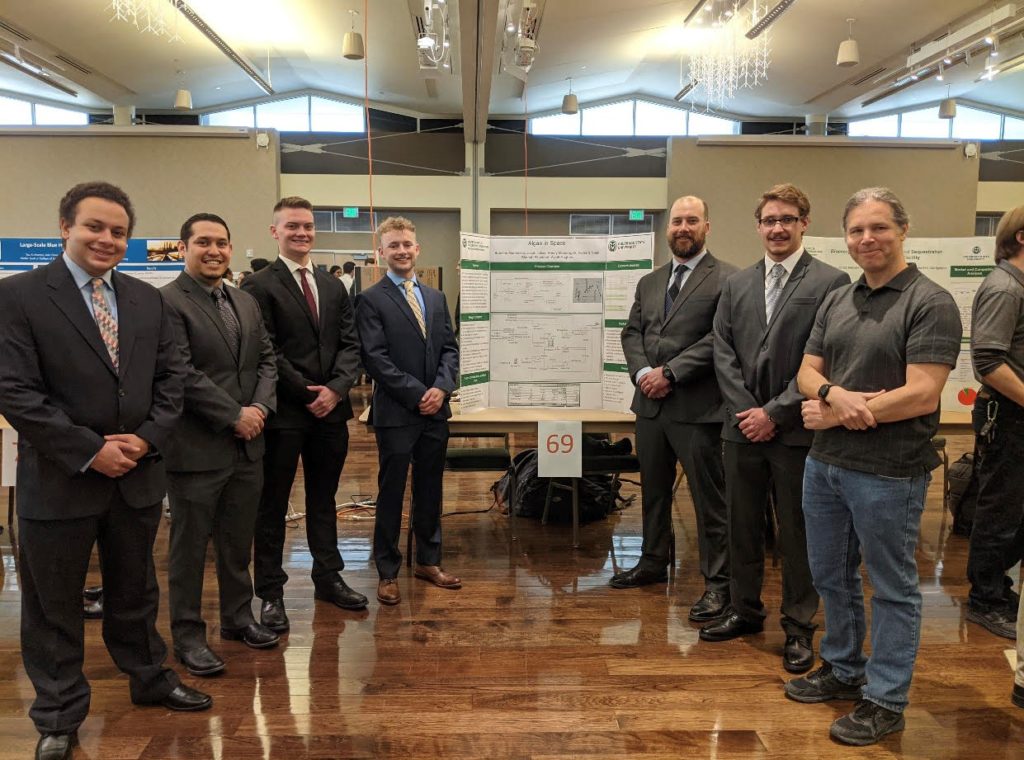
If human beings are going to land on Mars, there are an incalculable number of problems that must first be solved. Chief among them is the question of oxygen, a gas that can be hard to come by while floating through the void of space. For their senior design project, a group of CSU Chemical and Biological Engineering students studied the feasibility of supplementing this process with a natural solution – algae performing photosynthesis.
The “Algae in Space” team was made of six students: team leader Randy Mondragon, Richard Nash, Jacob Julius, Shehab Elhaddad, Wyatt Hughes, and Brandon Martenson. Brian Munsky was their faculty advisor.
Nash and Julius began to think about this enterprise during a recent internship with NASA. In their time there, they were assigned to a project which sent algae samples into the stratosphere to analyze how solar radiation would affect their cells. This led to further questions about the role that algae could play in making interplanetary travel a reality.
“We’re kind of on a bit of a precipice,” Nash said. “Maybe we’ll see humanity become this interplanetary species. It’s going to be kind of a historical moment. We were wondering how to become a part of it as chemical engineers.”
For chemical and biological engineers to be involved in aerospace, the main pathway is usually developing propulsion. ‘Algae in Space’ focused on another system that could use their expertise.
Oxygen on the International Space Station is created through electrolysis, separating the hydrogen and oxygen atoms that make up H2O. This process is irreversible and a heavy drain on a mission’s water supply. Using algae could prove to be more sustainable.
“Compared to plants, algae has really high photosynthetic efficiency,” Julius said. “They’re going to be able to pump out more oxygen for however much CO2 you put in.”
The team created a virtual model of a living area that might be used on Mars alongside a photobioreactor to test how the gas exchange might function. The bioreactor would take in CO2 from the crew’s breath and use photosynthesis to create oxygen.
“What we were finding was that you could get most of what you need as far as oxygen production,” Hughes said. “But it’s still going to need to be supplemented.”
“You would have to either supplement with electrolysis to get that extra boost of oxygen, or somehow bring in extra CO2,” Julius said. “One idea that we came up with was that if you’re on Mars, the atmosphere on Mars is 95 percent carbon dioxide. So maybe what you could do is take some of the carbon dioxide from the atmosphere.”
Although the main focus of the project was on oxygen production, the team considered Spirulina algae in particular for its versatility.
“It’s multipurpose,” Julius said. “You can use it for wastewater treatment, or biofuel production. In the case of [Spirulina], you can also use it for consumption.”
Spirulina is used on earth as a dietary supplement for humans and livestock, taking its flexibility a step further.
The system that the team designed would take up space, and at present there are certain stipulations that the system would have to meet to even be possible to send into space. These constraints were based on the specifications of the Perseverance Rover, which landed on Mars in February 2021.
“You don’t want to ship it up there and have it be broken.” Mondragon said. “Roughly the size of a small car was what we were working with for transportation purposes.”
Looking to the future, the prospect of humanity landing on Mars and beyond excited everybody in the team, for different reasons across the board.
“If something were to go wrong, a cataclysmic event where Earth was no longer able to be inhabited by people, that’s just the end of humanity?” Martenson said. “That’s a pretty sad story. Being able to travel further beyond the reach of our planet and colonize other planets would be the safety net.”
“Maybe we find something we can use to improve our situation here on other planets,” Nash added. “If we expand to other planets there’s no telling what we’re going to find.”